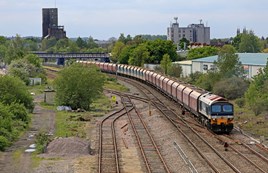Growth targets need to be set for freight in the future, regardless of which party gains power in July’s general election. This is alongside ensuring the ambitious targets are met and innovation and investment in the rail freight sector is supported.
This was the view of the panel at this year’s RAIL Live freight acceleration talk at the Policy & Leadership Theatre. The panel featured Julian Worth, freight lead at the Chartered Institute of Logistics and Transport (CILT) who told the audience that a growth target was needed to ensure the growth for rail freight continues the upward trajectory it has seen recently.
“A rail freight target is needed, absolutely. Because what it does is gives assurance that the industry is backed, and helps focus on what is really needed, which is a long-lasting modal shift.”
However, whilst the target is broadly welcomed, whether it was ambitious enough to ensure the modal shift happens, was debated.
“Considering where we were, any target is welcome. There was no real backing initially but there is a sense that realistically, it needs to happen.
“So whilst, in a broad sense, perhaps it isn’t ambitious enough, it is definitely a starting point for future growth targets”, believes Worth. However, Kathryn Oldale, head of strategy & policy & communications, DB Cargo UK commented that it wasn’t ambitious enough.
“It absolutely isn’t ambitious enough, whether it is 75%, 90% or 100%, it needs to have a structure and strategy to achieve it and the right help in place to ensure that the target is achieved.”
Oldale believes there are several ways for the target to be achieved in the future. This includes ensuring track access costs that have increased by 35% through inflationary increases are brought in-line with the fuel duty that road hauliers pay, which has not seen a significant increase in 14 years.
“There are ways that rail freight can be grown, and it starts with some of the fundamentals. This includes making sure track access costs are competitive with fuel duty. We can’t have barriers in place if companies are beginning to explore using rail freight.”, Oldale told the audience.
The panel also discussed reintroducing freight facility grants. The grants help address the high outlay of developing and modernising rail connected facilities. The scheme is available in Scotland and Wales but not England. Worth pointed out that engineering costs associated with developing rail connected facilities were going to need to be curbed with freight facility grants seen by the panel as a possible path in bridging the prohibitive costs seen currently.
















Login to comment
Comments
No comments have been made yet.